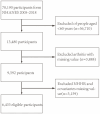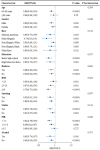The relationship between non-high-density lipoprotein cholesterol to high-density lipoprotein cholesterol ratio (NHHR) and rheumatoid arthritis: a cross-sectional study
- PMID: 40599547
- PMCID: PMC12211037
- DOI: 10.3389/fnut.2025.1594218
The relationship between non-high-density lipoprotein cholesterol to high-density lipoprotein cholesterol ratio (NHHR) and rheumatoid arthritis: a cross-sectional study
Abstract
Background: Research suggests a potential link between lipid metabolism and rheumatoid arthritis (RA). The ratio of non-high-density lipoprotein cholesterol (non-HDL-C) to high-density lipoprotein cholesterol (HDL-C) (NHHR) is a newly developed combined index to evaluate atherosclerotic lipids. This study aimed to explore the relationship between NHHR and the incidence rate of RA in the elderly in the United States.
Methods: This study analyzed data from the National Health and Nutrition Examination Survey (NHANES) collected between 2005 and 2018 to examine the association between NHHR levels and RA incidence, adopting multivariate logistic, subgroup analysis, and smooth curve analysis methods. Furthermore, the study investigated the potential mediating role of BMI and the use of statins in the RA-NHHR association through mediation analysis. The nonlinear aspect of the RA-NHHR relationship was explored using restricted cubic spline (RCS) analysis.
Results: This study enrolled 6,433 participants, with a mean age of 69.9 years. Males accounted for 51% of the cohort, while females comprised 49%. Among them, 1,359 individuals reported a history of RA. A one-unit increment in NHHR was associated with an 11% reduction in the risk of RA. [Odds ratio (OR): 0.87; 95% CI: 0.81-0.92]. We have extensively adjusted for various confounding factors and still reflect the above relationship. Subgroup analysis (all p for interaction < 0.05) showed that age, gender, race, smoking, drinking, statins, and diabetes had no significant impact on this negative correlation. Mediation analysis revealed a significant intermediary effect of NHHR on RA through statins (p for trend<0.01). Lastly, the RCS findings indicated a substantial non-linear association between NHHR and RA (p-non-linear<0.05). Due to the cross-sectional nature of this study, it is not possible to determine the causal relationship. Therefore, in future studies, we can utilize other research designs, such as prospective cohort studies, to validate the temporal relationship between the two.
Conclusion: Research has shown that NHHR levels are associated with a decrease in the incidence of rheumatoid arthritis in the elderly population in the United States. In addition, the linear relationship between RA and NHHR warrants further study.
Keywords: HDL-C; NHANES; NHHR; cross-sectional study; non-HDL-C; rheumatoid arthritis.
Copyright © 2025 Deng, Qiu, Wang, Jiang, Xiang, Guo, Yang, Li and Wu.
Conflict of interest statement
The authors declare that the research was conducted in the absence of any commercial or financial relationships that could be construed as a potential conflict of interest.
Figures




Similar articles
-
U-shaped relationship between the non-HDL to HDL cholesterol ratio and mortality in hypertensive individuals in the study from NHANES database.Sci Rep. 2025 Jul 1;15(1):20657. doi: 10.1038/s41598-025-07141-z. Sci Rep. 2025. PMID: 40596509 Free PMC article.
-
Associations between high-density lipoprotein cholesterol, non-high-density lipoprotein cholesterol, and their ratio with metabolic dysfunction-associated steatotic liver disease: a retrospective cohort study.Front Endocrinol (Lausanne). 2025 Jun 18;16:1585811. doi: 10.3389/fendo.2025.1585811. eCollection 2025. Front Endocrinol (Lausanne). 2025. PMID: 40607232 Free PMC article.
-
Threshold effect of non-high-density lipoprotein to high-density lipoprotein cholesterol ratio and hypertension in U.S. adults: NHANES 2005-2016.Medicine (Baltimore). 2025 Feb 21;104(8):e41585. doi: 10.1097/MD.0000000000041585. Medicine (Baltimore). 2025. PMID: 39993081 Free PMC article.
-
Effects of a gluten-reduced or gluten-free diet for the primary prevention of cardiovascular disease.Cochrane Database Syst Rev. 2022 Feb 24;2(2):CD013556. doi: 10.1002/14651858.CD013556.pub2. Cochrane Database Syst Rev. 2022. PMID: 35199850 Free PMC article.
-
Systemic pharmacological treatments for chronic plaque psoriasis: a network meta-analysis.Cochrane Database Syst Rev. 2017 Dec 22;12(12):CD011535. doi: 10.1002/14651858.CD011535.pub2. Cochrane Database Syst Rev. 2017. Update in: Cochrane Database Syst Rev. 2020 Jan 9;1:CD011535. doi: 10.1002/14651858.CD011535.pub3. PMID: 29271481 Free PMC article. Updated.
References
-
- Dougados M, Soubrier M, Antunez A, Balint P, Balsa A, Buch MH, et al. Prevalence of comorbidities in rheumatoid arthritis and evaluation of their monitoring: results of an international, cross-sectional study (Comora). Ann Rheum Dis. (2014) 73:62–8. doi: 10.1136/annrheumdis-2013-204223, PMID: - DOI - PMC - PubMed
LinkOut - more resources
Full Text Sources

